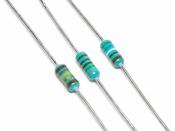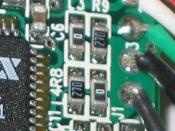Investigating the resistance of Nichrome wire.
Aim
In this investigation, I am going to be invstigating how the length of Nichrome wire affects the resistance that is applied.
Prediction
In 1826, Georg Ohm discovered that the current flowing through a metal wire is proportional to the potentail difference across it, it basically means if you double the potential difference you double the current. The thin wire in a lamp tends to resist the movement of electrons in it, this means that the wire has a certain resistance to the current. The greater the resistance, the more voltage is needed to push a current through the wire, the resistance of a wire is calculated by:
Resistance, R= p.d across the wire(V) /current through the wire(I)
Their are four factors affecting resistance they are:
1) As the length increases, the resistance increases
2) As cross-sectional area increases, the resistance decreases
3) Copper is a good conductor
4) As temperature increases, the resistance of a wire increases
Using the information above I will be able to get an idea what my results would look like after I do the experiment.
I think that 'As the length of the wire increases so does the resistance', one of the four factors that affect resistance of wire is as the length increases, the resistance increases, this show that my prediction may be right.
Apparatus
Below are the apparatus that I will be using:
1)Nichrome Wire
2)Cell: Power supply
3)Variable Resistor: To fine tune the voltage
4)Voltmeter: To measure the voltage
5)Ammeter: To measure the current
6)Ruler: To measure wire length
7)Wires
A pilot experiment is when you do a experiment before you do the real experiment to see that it would be a fair test and to make sure everything is in working order.
Method
I will use one metre of Nichrome wire so that I may experiment with different lengths of wire, first I will need a Cell and five Wires I will fix the first wire from the cell to the Ammeter, and a wire from the ammeter to the Fixed Resistor, a wire from the Fixed Resistor to the Variable Resistor and connect it to the cell, and I will fix a Voltmeter around the Fixed Resistor. The ammeter will will measure the current going through the wire as it goes on the voltmeter will measure the voltage going through the fixed resistor, since the voltage that goes throught the fixed resistor is not accurate, I will fix a variable resistor, to get a more accurate output. I will then record the length of the wire, the voltage and the resistance, and would hopefully get accurate results.
Fair Testing
Some factors will affcet the final result if they are not taken care of, or if you do not take precutions. Some of the factors that will most probably affect the final results are: I will have to keep the standard wire gage the same through out the whole experiment, I will also have to keep the voltage the same otherwise it might affect the results, however the most important factor I will have to look out for is the temperature 'As temperature increases, resistance of wire increases' if the temperature changes the resistance will change with the temperature, this factor may affect my results significantly, and there may be nothing to stop this factor affecting my results.


